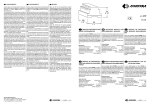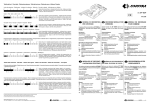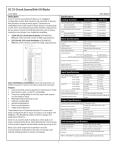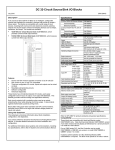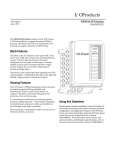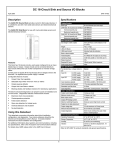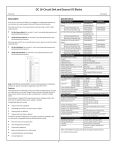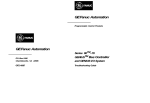Download Genius 16-Ckt Relay Output Block datasheet, GFK
Transcript
16-Ckt Relay Output Block May 2009 GFK-0038F Description Compatibility Relay Output blocks provide 16 output circuits in four independent groups of four relay-type outputs each. The block power may be either 115V or 230V AC. There are two types of Relay Output blocks: These blocks are compatible with a Hand-held Monitor identified by catalog number IC66*HHM501 only. For IC693 Series PLCs, and IC695 and IC698 series PACs, all versions support these blocks. Normally-Closed (NC) Relay Output Block (IC66*BBR100), Normally-closed contacts For an IC697 series PLC, the CPU and programming software must be version 2.0 or later. The Bus Controller must be IC697BEM731C or later. Normally-Open (NO) Relay Output Block (IC66*BBR101), Normally-open contacts For an IC600 series PLC, the CPU must be revision 105 or later. For an IC600 “Plus” series PLC, revision 110 or later is required. The programming software must be release 4.02 or later. For an IC550 series PLC, the CPU must be revision 3.0 or later. The programming software must be release 2.01 or later. Relay blocks are compatible with a wide range of low-power control and indicating devices. Output devices may operate in the range of 5V to 250V AC or 5V to 220V DC, and switch up to 60 Watts or 125 VA. Revision Information Catalog Numbers Output Block, NC Relays IC66*BBR100 Electronics Assembly IC66*EBR100 Terminal Assembly IC66*TBR100 Terminal Assembly IC66*TBR110 Output Block, NO Relays IC66*BBR101 Electronics Assembly IC66*EBR101 Terminal Assembly IC66*TBR101 Terminal Assembly IC66*TBR111 Note: IC66*TBR110 and TBR100 can be used interchangeably as replacement parts. Likewise, IC66*TBR111 and TBR101 can be used interchangeably. The function and compatibility of these parts have not changed. However, if a Terminal Assembly that is not UL certified is used as a replacement part in a BBR100 or BBR101 Output Block, the overall assembly will not be UL certified. UL certifications are removed from the following products: Output Block, NC Relays IC66*BBR100-P and later Electronics Assembly IC66*EBR100-N and later Terminal Assembly IC66*TBR110A and later Output Block, NO Relays IC66*BBR101-P and later Electronics Assembly IC66*EBR101-N and later Terminal Assembly IC66*TBR111A and later The following products are UL certified: Terminal Assembly IC66*TBR101, all revisions Terminal Assembly IC66*TBR100, all revisions Thermal Derating Curve for IC66*BBR10xP and Later Versions 16 12 Number of Points On 8 4 10 20 30 40 50 60 Module Ambient Temperature°C) ( Features Each group of four outputs on a Relay Block can be powered by a separate AC or DC source. Group to group isolation is 1500 volts. Using this Datasheet Block features include: This datasheet provides release-specific information about the IC66*BBR100/101 blocks. It also summarizes information about Block installation, configuration, and diagnostics. Output powerup defaults Output Hold Last State or default CPU Redundancy type For additional information about systems and communications, including bus specifications, refer to the I/O System and Communications Manual, GEK-90486F-1. Bus Switching Module control For detailed instructions for Block installation and configuration, refer to the Discrete and Analog Blocks User’s Manual, GEK-90486D-2. Refer to GFK-0867 for product standards and general specifications. 1 16-Ckt Relay Output Block May 2009 GFK-0038F Specifications Block Specifications Size (height x width x depth) Weight LEDs (I/O Block) LEDs (each circuit) Environmental Specifications Operating Temperature Storage Temperature Humidity Vibration Block Power Specifications Frequency Operating voltage Power requirement Power supply dropout time Isolation All outputs to chassis ground Between output groups Power terminals to chassis ground Power terminals to outputs Comms terminals to power terminals Comms terminals to outputs Heat Dissipation Output Specifications Maximum output current Maximum switching power Maximum inrush current Maximum return current Output OFF leakage current Maximum switching frequency Output turn-on delay (maximum) Output voltage range Minimum recommended load Relay Specifications Relay type Initial Contact Resistance Typical Life: Carefully inspect all shipping containers for damage. If any equipment is damaged, notify the delivery service immediately. Save the damaged shipping container for inspection by the delivery service. After unpacking the equipment, record all serial numbers. Save the shipping containers and packing material in case it is necessary to transport or ship any part of the system. 8.83” (22.44cm) x 3.34” (8.48cm) x 3.91” (9.93cm) 4 lbs. (1.8 kg) Unit OK, I/O Enabled Individual relay coil state Block Mounting 0° to +60° C (32° to +140° F) -40° to +100° C (-40° to +212° F) 5% to 95% (non-condensing) 5-10 Hz 0.2” (5.08mm) displacement, 10-200 Hz at 1G Genius I/O blocks are considered "open type equipment" and therefore must be installed within a protective enclosure. They should be located in an area that is clean and free of airborne contaminants. There should be adequate cooling airflow. The block can be mounted right side up, or upside down. Leave at least 2 inches of space between blocks. Mount the block by drilling two screw or bolt holes for 8-32 hardware. Position the block so that the notches in the upper and lower flanges line up with the mounting holes. Mount the block using 8-32 screws. Use star washers to provide ground integrity. 47-63 Hz (115VAC) 93 to 132VAC; (230VAC) 185 to 265VAC 87mA at 115VAC 1 cycle Grounding The Block’s mounting screws must not be used as the only means of grounding the block. Connect the green ground screw on the Block to a reliable ground system using a short wire lead, minimum size AWG #12 2 (avg 3.3mm cross–section). 1500VAC 1500VAC 1700VDC 1500VAC 1700VDC WARNING If mounting screws do not make good ground connection and the ground screw is not connected to a reliable ground, the Block is not grounded. Electrical shock hazard exists. Death or personal injury may result. 1500VAC 10.1 watts maximum with 16 outputs on. Block Wiring 2 Amps per circuit 60 watts or 125 VA 2 Amps per circuit 5A per Group 0.1mA 20 cycles/minute 5ms 5V to 250V AC or 5V to 220V DC 10mA Do not over torque the terminal screws. Recommended torque for all terminals is 6 in/lb (.678 N/M). Serial Bus Wiring Using one of the cable types recommended in the System and Communications User's Manual, connect the serial bus to terminals1-4 as shown. (If the block will be used as a BSM controller, do not attach the serial bus to terminals 1-4. See "Using a Relay Block as a BSM Controller" instead). Terminals 1 to 4 are for the serial bus. These terminals accept one AWG 2 2 #12 wire (avg 3.3mm cross-section) or two AWG #14 wires (avg 2.1mm in cross-section). The minimum recommended wire size is AWG #22 (avg 2 0.36mm in cross-section). Terminals 1 -4 can also accommodate spade or ring terminals up to 0.27 inch (6.85mm) wide with a minimum opening for a #6 screw, and up to 0.20 inch (5.1mm) depth from the screw center to the back barrier. Be sure unshielded wire ends are not longer than 2 inches (5cm). Fixed coil moving armature 100 milliohms, maximum Maximum Current for Resistive Load 0.5A 1.0A 0.3A 0.6A 2.0A Resistive Load on Operating Life 0.3A 0.3A 1.0A Operating Voltage 250VAC 125VAC 220VDC 110VDC 30VDC Effect of 250VAC 125VAC 30VDC Installation Instructions Typical Life (operations) 200,000 100,000 100,000 200,000 500,000 If the block is at either end of the bus, connect a terminating resistor of the appropriate type (see the System and Communications User’s Manual for details) across its Serial 1 and Serial 2 terminals. 700,000 1,000,000 1,000,000 Typical Life (operations) indicated for 20°C ambient environment. 2 16-Ckt Relay Output Block May 2009 GFK-0038F Using a Relay Block as a BSM Controller Block Power A Relay block can be used to control a Bus Switching Module. There are two different BSM versions available. It is important to match the BSM to the type of voltage that will power the block’s outputs. If the voltage will be 24/48 VDC, BSM version IC66*BSM021 is required. If the voltage will be 115 VAC or 125 VDC, IC66*BSM120 is needed instead. Relay Output blocks require a 115 VAC or 230 VAC power source. Voltage selection is made by jumpers on the Terminal Assembly. When shipped from the factory, the power selection jumpers are set for 115 VAC operation. For 230 volt AC power, change the jumpers as shown. Correct jumper placement is important; incorrect jumper placement may result in damage to the block. Connect the power source to the H and N terminals. Install the BSM at the block’s serial bus terminals, as described in the Bus Switching Module datasheet. Connect the bus cable to the BSM. Connect the BSM wires to the block as explained below. For applications where Class 1 Division 2 conditions must be met for Factory Mutual, install an external 250 volt 1/8 amp slow-blow fuse in series with the Hot AC power connector as shown below. Field Wiring You can use either solid or stranded wire, however do not mix the two types of wire on the same contact terminal. Terminals 5 to 32 are for field devices. They take a single wire up to AWG 2 #14 (avg 2.1mm in cross-section). Minimum recommended size is AWG 2 #20 (avg .54mm in cross-section). Power for AC loads may come from the block AC power supply or other AC source(s). Power for DC loads may come from one or more DC sources. Each group may use a separate AC or DC source. With the external fuse indicated, this block meets FM Class 1 Division 2 requirements. Block and Points Powered by 115VAC If the block and points are powered by 115 VAC, connect one wire of BSM version IC66*BSM120 to point 1 and connect the other BSM wire to N. Jumpering terminal J1 to COM as shown above right allows the points to operate on the same 115 VAC source that powers the block. Block Powered by 230VAC, Points Powered by 24-48VDC If the block is powered by 230VAC and the points are powered by a 24-48 VDC source, connect one wire of BSM version IC66*BSM021 to point 1 and the other to DC- (24-48VDC). 3 16-Ckt Relay Output Block May 2009 GFK-0038F Block Powered by 230VAC, Points Powered by 115VAC or 125VDC Inserting an Electronics Assembly 1. If the block is powered by 230 VAC and the points are powered by either a 115 VAC source or a 125 VDC source, use BSM version BSM120. Connect one wire of the BSM to point 1. For a 125 VDC source, connect the other BSM wire to DC-. For a 115 VAC source, connect the other BSM wire to the neutral side of the power supply. Align the Electronics Assembly in the guides and push down firmly. CAUTION Do not exert excessive force; it may damage the Block. 2. If unusual resistance is met, remove the Electronics Assembly. If power is applied to the Block, DO NOT TOUCH THE CONNECTOR PINS! Inspect the Terminal Assembly, connector receptacle, and connector edge board (on the Electronics Assembly). Be sure the keying matches. Remove any obstacles and reinsert the Electronics Assembly. Pay close attention to the alignment of the guide pins. 3. Secure the Electronics Assembly with the screws on the top and bottom of the Terminal Assembly. Block Operation All 16 relay-type outputs are either normally open (NO) or normally closed (NC), depending on the block version. Outputs are grouped into four groups of four relays. Each group of four shares a common input terminal. Each circuit has its own LED that shows the commanded state of the coil. A logical ’1’ received from the CPU causes the block to energize the corresponding relay coil, and ’0’ causes the coil to be de-energized. This has opposite effects on these two blocks. When the coil of a NO relay is energized, the relay is energized and the relay contact closes. When the coil of a NC relay is energized, the relay contact opens. The Relay Output blocks provide an EEPROM Failure diagnostic only. There are no diagnostics associated with the individual circuits. Circuit LEDS show the commanded state of each coil. External Fuses and Snubbers Relay blocks have no internal fuses. Following normal practices, external fuses of 2 Amps or less can be installed in series to protect loads. External snubbers are not necessary for correct operation of the block. However, the use of snubbers is recommended. Snubbers will reduce switching transient pulses and lengthen the contact life of the relays. Removing an Electronics Assembly The Block’s Electronics Assembly can be replaced without removing field wiring or reconfiguring the Block. Electronics Assembly Retaining Screws (Qty. 2) Terminal Assembly Connector Pins 1. Unscrew the retaining screws at the top and bottom of the Block. 2. Using a Block Puller (IC66*BLM507), engage the tabs in the first vent slots. Move the tool to the center of the Block and squeeze the handle. 3. Pull the Electronics Assembly upward. Note: WARNING If power is applied to the field terminals, power is also exposed on the connector pins at the base of the Terminal Assembly, and an electrical shock hazard exists. Do not touch the connector pins! Death or injury may result. 4 Relay NO version shown. NC is the same except for relay type. 16-Ckt Relay Output Block May 2009 GFK-0038F LEDS Installation in Hazardous Locations The Unit OK and I/O Enabled LEDs show the block’s operating status. I/O Meaning Unit OK Enabled THIS EQUIPMENT IS SUITABLE FOR USE IN CLASS I, DIVISION 2, GROUPS A, B, C, D, OR CLASS I ZONE 2 GAS GROUP IIC HAZARDOUS LOCATIONS ONLY. ON ON Block functioning, CPU communicating ON OFF Block functioning WARNING - EXPLOSION HAZARD - SUBSTITUTION OF COMPONENTS MAY IMPAIR SUITABILITY FOR HAZARDOUS LOCATIONS No CPU communications for 3 bus scans ON Blinking Block functioning, Circuit forced Blinking ON Circuit fault, CPU communicating Blinking OFF Circuit fault WARNING - EXPLOSION HAZARD - DO NOT CONNECT OR DISCONNECT EQUIPMENT UNLESS POWER HAS BEEN SWITCHED OFF OR THE AREA IS KNOWN TO BE NON-HAZARDOUS. No CPU communications for 3 bus scans Alternate Blinking Circuit fault, Circuit forced Synchronous Blinking No CPU communications - Block number conflict OFF No Block power, or Block faulty Don’t Care Individual circuit LEDS show the commanded state of each coil. Configuration A Block must be configured with a Hand-held Monitor to: Enter its Block Number (serial bus address). Enter its Reference Number (required for IC550 and IC600 series PLCs only). Note: If a block is configured offline, it must be properly grounded and have a 75 Ohm resistor installed across its Serial 1 and Serial 2 terminals. See the Discrete and Analog I/O Blocks User’s Manual for instructions. The rest of the features can be configured either using a Hand-held Monitor, or by sending a Write Configuration datagram to the block from the host. Feature Device Number Circuit or Block Block Factory Setting Null Reference Address Baud Rate Block None Block 153.6 std Hold Last State Output Def. State BSM Present BSM Controller Outputs Default Time Redundancy Mode Circuit Circuit Block Block Block Block No Coil off No No 3 bus scans None Duplex Default Configuration Protection Block Block Off Disabled Selections 0 to 31 (a number must be selected) Depends on host CPU type 153.6 std, 153.6 ext, 76.8, 38.4 Kbps Yes, No Coil On, Off Yes, No Yes, No 2.5, 10 seconds None, Duplex, Hot Standby On, Off Enabled, Disabled 5






